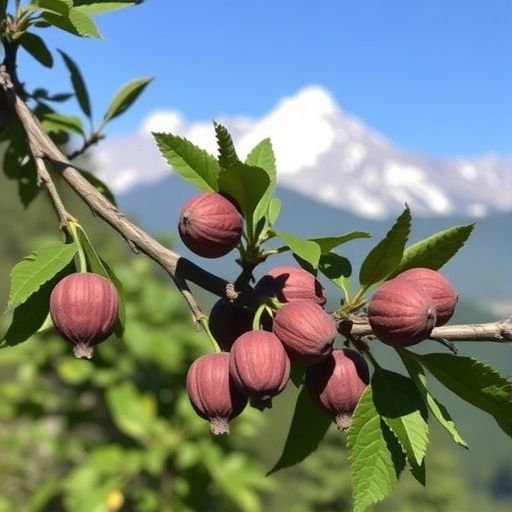In the realm of agricultural research and plant genetics, the Persian walnut, known scientifically as Juglans regia, has emerged as a focal point of inquiry, especially in the diverse ecosystems of the North-Western Himalayan region. The latest study conducted by a team of researchers, including Ahir, Chauhan, and Sharma, delves into the selection of superior genotypes of this species. These trees, which have originated from seedlings, serve as an important genetic reservoir for traits that may enhance agricultural yield, resistance to pests, and adaptability to changing climatic conditions.
The methodology employed in this study stands as a testament to the advancements in multivariate analysis in understanding morphological characteristics. Multivariate analysis allows researchers to investigate complex interactions among various traits simultaneously rather than in isolation. Such a systematic approach sheds light on how specific traits contribute to the overall health and productivity of the walnut trees, providing a robust framework for tree selection that can significantly impact agricultural practices.
In their research, the team meticulously documented various morphological traits of the walnut genotypes. This involved assessing attributes like leaf size, fruit weight, and tree height, which all play crucial roles in determining the adaptability of the walnut trees to their environment. By analyzing these traits, the researchers could identify which genotypes exhibited superior characteristics that not only promise higher yields but also possess resilience against environmental stresses.
The findings of this study are particularly relevant given the backdrop of climate change and the increasing pressures on agricultural systems. The North-Western Himalayan region, with its unique climatic and soil conditions, provides an ideal setting for the cultivation of Persian walnuts. However, with unpredictable weather patterns becoming the norm, there is a pressing need to adopt cultivation strategies that favor the most resilient and productive genotypes.
Genetic diversity is crucial for the long-term sustainability of any agricultural species, and Persian walnuts are no exception. The researchers emphasized that selecting the right genotypes can help enhance genetic diversity in cultivated populations, thereby increasing their resilience. This genetic pool can serve as a buffer against pests, diseases, and climate variability, ensuring that farmers have access to robust crops that can thrive under adverse conditions.
The implications of this research extend beyond theoretical insights into practical applications for farmers in the region. By empowering local agricultural experts with knowledge about which genotypes to prioritize, the study provides actionable recommendations that can lead to improved agricultural productivity. Farmers are likely to benefit directly from the adoption of these findings, translating research into practice and enhancing food security in the region.
In addition to theoretical contributions, the researchers have laid the groundwork for future studies aimed at genomic and molecular characterization of these walnut varieties. Understanding the genetic basis of preferred traits is essential for more targeted breeding programs that could expedite the development of new and improved variants. This could potentially transform walnut cultivation not just in the Himalayas but across various ecological zones where they are grown.
Moreover, the study serves as a crucial link in the chain of sustainable agricultural practices. As the world grapples with the impact of climate change, the emphasis on sustainable and resilient crop varieties cannot be overstated. This research aligns with global efforts to promote biodiversity and sustainable agricultural practices, highlighting the need for local adaptations to regional conditions.
As the scientific community delves deeper into the complexities of plant genetics and morphology, studies like this demonstrate the importance of integrating both traditional knowledge and modern analytical techniques. The collaboration of researchers with local agriculturalists further enhances the potential for success, as the practical experience of those who work directly with the land offers invaluable insights that can refine scientific approaches.
Looking ahead, the potential role of biotechnology in improving the characteristics of Persian walnuts cannot be ignored. Advances in biotechnological tools may facilitate quicker and more efficient selections of desirable traits, expediting the time needed to cultivate robust trees and increase yields. This could revolutionize the way creamy, nutritious walnut products reach consumers, creating a ripple effect in health and nutrition on a global scale.
The local economy stands to gain significantly from enhanced walnut cultivation. As superior genotypes are established, the region’s farmers can expect not only improved productivity but also increased income from higher-quality walnut yields. This economic boost can invigorate rural communities, fostering greater investment in sustainable agricultural practices and furthering the cycle of improvement in crop production.
In summary, the comprehensive study on the selection of superior Persian walnut genotypes stands as a beacon of hope for those involved in agriculture in the North-Western Himalayan region. By adopting a data-driven approach to tree selection grounded in morphological traits, farmers can fortify their practices against modern challenges. This research highlights the interconnectedness of genetic diversity, sustainable agriculture, and economic viability in a rapidly changing world.
As we look to the future, the continued exploration of genetic traits in crops like the Persian walnut will undoubtedly contribute to more resilient agricultural systems. Research efforts must persist in identifying and cultivating the best possible varieties, ensuring that both local communities and global markets can benefit from the fruits of these endeavors. The insights gained from such studies may very well shape the future landscape of agricultural cultivation, aligning with ongoing efforts to achieve food security and sustainability throughout the world.
Subject of Research: Selection of superior Persian walnut (Juglans regia) genotypes from seedling-originated trees in the North-Western Himalayan region.
Article Title: Selection of superior Persian walnut (Juglans regia L.) genotypes from seedling-originated trees in the North-Western Himalayan region based on morphological characterization using multivariate analysis.
Article References:
Ahir, M., Chauhan, J.K., Sharma, D.P. et al. Selection of superior Persian walnut (Juglans regia L.) genotypes from seedling-originated trees in the North-Western Himalayan region based on morphological characterization using multivariate analysis.
Sci Nat 112, 83 (2025). https://doi.org/10.1007/s00114-025-02012-z
Image Credits: AI Generated
DOI: https://doi.org/10.1007/s00114-025-02012-z
Keywords: Persian walnut, Juglans regia, morphological characterization, multivariate analysis, seedling-selection, genetic diversity, sustainable agriculture.




